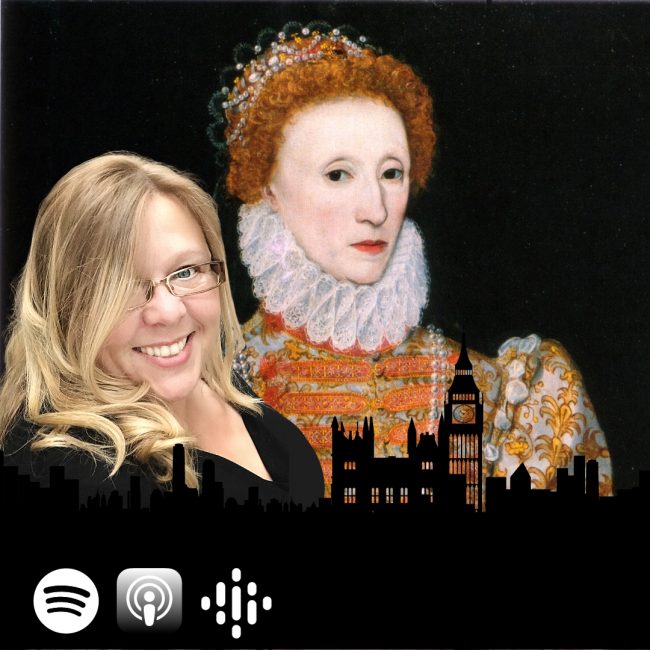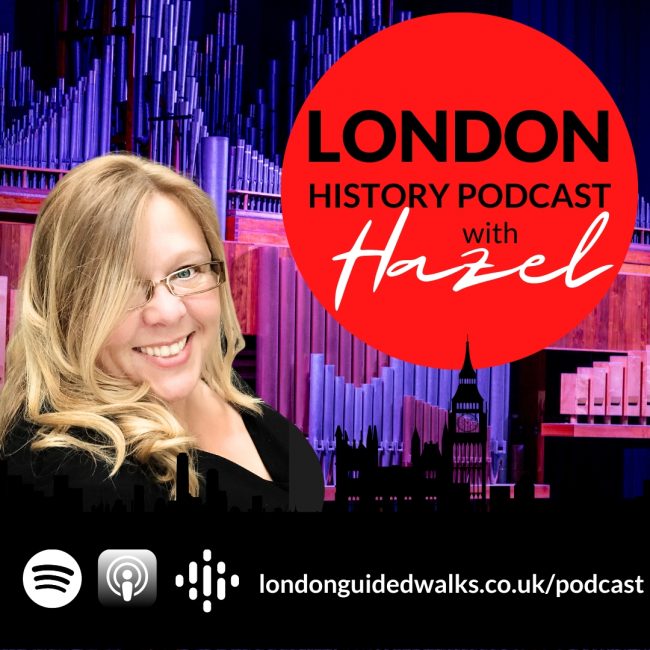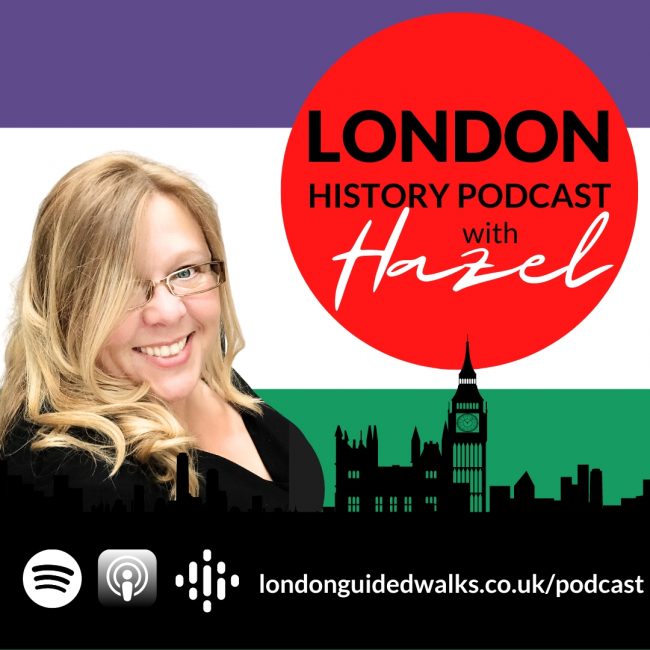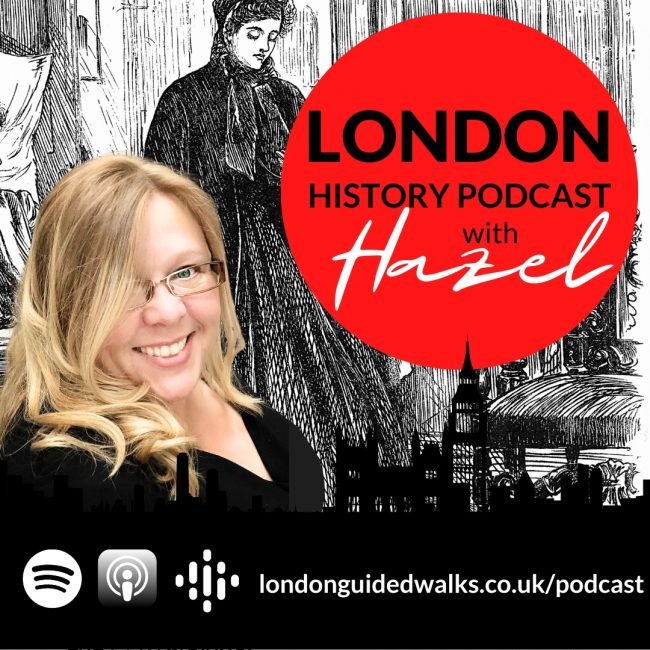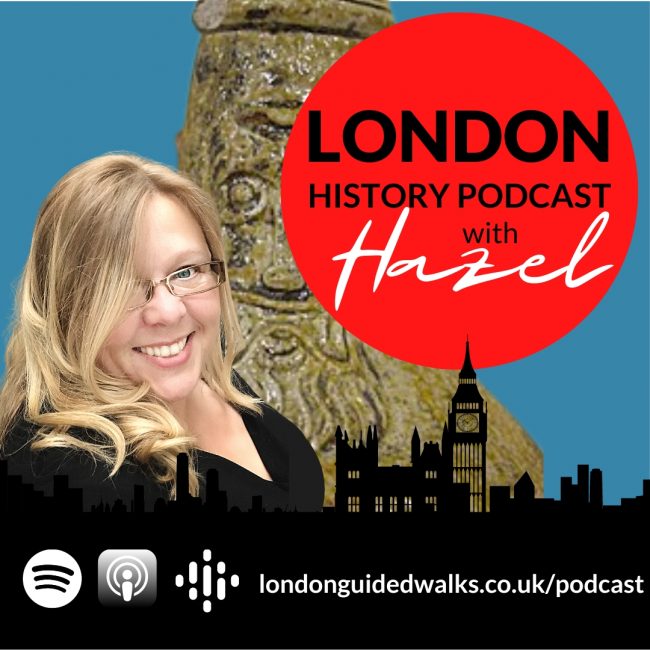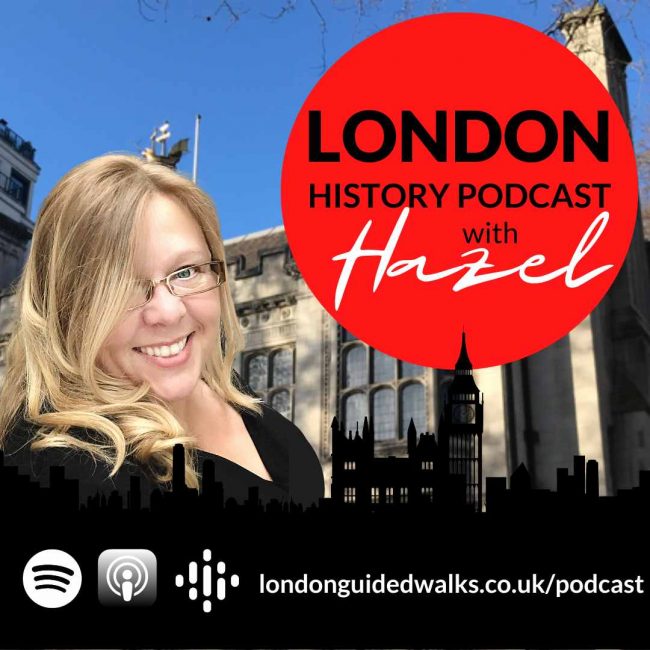Read Corina’s blog
Correction: John Foxe’s Annals is called Acts and Monuments
Transcript:
Hazel: Hello, and welcome to our London History podcast, where we share our love of London. It’s people, places, and history. It’s designed for you to learn things about London that most Londoners don’t even know. I am your host, Hazel Baker, a Qualified London Tour Guide and CEO and founder of londonguidedwalk.co uk
Each episode is supported by show notes, transcripts, photos and further reading, all to be found on our website. Click on londonguidedwalks.co.uk/podcast and then select the episode that you fancy. And if you enjoy what we do, then you’ll love our guided walks and private tours that we offer throughout the year.
So get that cup of tea, put your feet up and enjoy.
Corina Apostu emerges as a scholar deeply entrenched in the rich tapestry of England’s Elizabethan history. With an academic background rooted in the University of Kent, where she pursued a Master of Arts in Medieval and Early Modern Studies, Corina has dedicated a significant portion of her scholarly endeavour to understanding the intricate dynamics of court politics during the reign of Elizabeth I.
Her dissertation offers a compelling exploration of the demise of Robert Dudley, Earl of Leicester — a nobleman of considerable influence and a pivotal figure within the Elizabethan court. Dudley’s death is not merely a historical footnote but a transformative event that sent ripples through the political and social fabric of the era. This subject, no doubt, requires a meticulous examination of the period’s complex power structures, the delicate balance of favour and faction at Elizabeth’s court, and the personal relationships that could both elevate and undo the most powerful of nobles.
The relationship between Robert Dudley and Queen Elizabeth I is, indeed, one of the most fascinating aspects of this period. Their alliance was characterised by an intriguing blend of personal intimacy and political alliance, a relationship that has captivated historians and enthusiasts alike. Dudley was not only a close confidant and favourite of the Queen but also a constant presence in the political machinations of the time, which made him a significant character in the annals of English history.
Connecting this historical intrigue to the imposing presence of the Tower of London adds a compelling layer to Corina’s narrative. The Tower, with its own deep-rooted history in royal drama, imprisonment, and execution, stands as a sombre reminder of the era’s turbulence. It is a monument that has witnessed the zeniths and nadirs of English royalty and nobility, including the figures that Corina has studied so extensively.
For Corina, the Tower of London is not just a landmark of stone and spire; it’s a nexus of the historical tales she has unravelled, a silent witness to the secret whispers and public proclamations that shaped the Elizabethan court. Her studies provide her with a unique lens through which to view this iconic edifice, one that is coloured by her deep understanding of the personalities and events that once haunted its halls and courtyards.
Today we will be talking about their connection to one of the most imposing and imposing landmarks in London – the Tower of London.
Questions:
- Who is Robert Dudley?
- So how are Robert and Elizabeth related to the Tower of London?
- Was Northumberland himself taken to the Tower?
- Did Elizabeth and Robert meet while in the Tower?
- So there was no way for them to communicate at all?
- Can you visit the place where they were held as prisoners?
Welcome, Corina. Thanks
[00:03:08] Corina Apostu: so much for having me, Hazel. I’m really excited to talk about this, uh, topic. One of my favorites. Oh, you’re
[00:03:14] Hazel: telling me. I mean, Elizabeth I is one of my favorites.
Anyway, I don’t really need an excuse to talk about her, but you can’t know everything, which is where you come in. But I think maybe it’s worth starting off with maybe the lesser known of the two names that we’re talking about. And that is Robert Dudley. So who is? Robert Dudley.
[00:03:42] Corina Apostu: Right, well, as you say, pretty much everyone knows who Elizabeth I is.
Um, but sometimes when I mention Robert Dudley to people, I kind of get blank stares in response. So, as you say, who is this man? Uh, Robert Dudley was the fifth son of John and Jane Dudley, who were the Duke and Duchess of Northumberland, though they were only up and coming gentry when Robert was born in June of 1532, and he was only a year older than Elizabeth herself.
As an adult, he was a courtier, politician, and magnate in Elizabeth’s court, but alongside that, he was also her long held favourite, companion, and one of her oldest and dearest friends. In fact, they were so close and openly affectionate with each other that there were constant rumours claiming that they were lovers.
Robert even became one of the strongest contenders for Elizabeth’s hand in marriage after his first wife, Amy, died in mysterious circumstances in 1560. They never did marry, obviously, but they remained close for the rest of their lives together. Whether they were indeed lovers or not is beyond the scope of this podcast, but what is most important to know for today is that they had been in each other’s orbits since childhood.
We know this because Robert later told a French ambassador in 1566 that he had known Elizabeth since she was eight years old, and she had told him that she never wanted to marry even at that tender age.
[00:05:03] Hazel: And how close were they in childhood, do we know?
[00:05:06] Corina Apostu: How close they were in childhood is impossible to determine with any certainty, but Elizabeth clearly felt comfortable enough to divulge such a personal desire to him as children, and the Dudley family had always been near to the centre of the English court.
Robert’s father was a talented politician and soldier, and his mother once served Anne Boleyn as
[00:05:27] Hazel: lady in waiting. He’s got to have been a handsome so and so as well.
[00:05:32] Corina Apostu: Yes, funnily enough, there is actually quite, quite a few, um, ambassadors commented on that he was a, uh, a beautiful man or a handsome man of some sort.
And it, it, it, it truly is, uh, uh, amusing to read, especially because half the time they, Also couldn’t stand him as a person, but they had to admit he was pretty handsome.
[00:05:55] Hazel: Ah, now you can sit working in the city like that now. So he was handsome. He had obviously training from the skills from his father and the, the knowledge from his mother working at court because, you know, being a favorite for so long for someone who we often understand with Elizabeth is, um, quite tempestuous in her, um, Um, in her friendships, pulling and, uh, uh, and pushing at the other courts of the courts of friendship.
Um, he stays there with her. So he must’ve been able to find a particular niche that no one else could.
[00:06:35] Corina Apostu: Yes, absolutely. And I think this kind of goes back to, it is related to what we’re going to speak about today. And a part of it, I think is the longevity of the relationship. The, the depth of their bond, simply because for how long they’ve known each other, for how many things they went through, which were very similar, uh, I think it struck a very deep bond between them.
And Elizabeth knew that she could trust him, despite what everyone else was thinking. And, and, and Elizabeth, Really cherish the people she knew she could trust. Uh, we kind of have this idea of the tutors being, you know, like lopping off the heads of everybody they loved. That’s more Henry viii . He’s kind of the, the ax, happy one.
Uh, Elizabeth was far more, uh, hesitant with, with the act. Certainly plenty of people were executing her reign too, but she was deeply, deeply reluctant to turn on those. who were, who were very close to her and who she was emotionally connected to and who she had tested and had seen, right, yeah, you’re trustworthy and Robert Dudley was
[00:07:46] Hazel: one of them.
I suppose being monarch in any age, um, you’re going to be limited by a very small number of people that you can trust, your inner circle as it were. Oh yeah. Yeah. And I suppose for Elizabeth as well, you know, bypassing the, the life expectancy age and people popping off and, um, that circle getting smaller and smaller as well.
And if you think of times when she feels like she really has been let down. If you think about, uh, Latice Knowles, for example, she really does flip one because it’s a, it’s a personal attack to her. Absolutely,
[00:08:24] Corina Apostu: I, I, I fully agree with that. And I think a lot of people view that whole scenario as kind of Elizabeth being monstrously jealous.
And, and certainly she was a very possessive and jealous woman. What people kind of fail to understand is that She had also been extremely close to the Dolly’s family, to Letizia’s entire family, and potentially to Letizia herself. Uh, and so when it comes out that Letizia had married Robert Dudley, it must have felt like an almighty stab in the back, and obviously Elizabeth did not handle it very well, but I almost don’t blame her.
I feel like I, I, I understand just from an emotional point of view. why she reacted that way, although certainly I think she took it a little bit too far with how long she held that grudge and how, uh, you know, hostile she was to Letiz for the rest of their lives. Um, but again, that’s, that’s beyond the scope of this.
But it’s interesting you mention that because, uh, it brings to mind, Elizabeth once said something like, um, I have found treason in trust, um, which is that she has had her trust betrayed many, many times. Uh, and so those who… to be loyal to her. She was very grateful for, and even with Robert, when he did occasionally hurt her, either politically or personally, he always seemed to be able to make it up to her or at the very least, she was able to eventually forgive him, um, because he proved his metal in other ways.
[00:10:04] Hazel: Yeah, yeah. And now our particular focus today is the Tower of London and the relationship with Robert Dudley and Elizabeth I with the Tower of London specifically. So how are Robert and Elizabeth related to the Tower of London?
[00:10:21] Corina Apostu: Well, you know, as Most people will know from their history lessons, uh, the Tower of London was originally built by William the Conqueror and acted in the beginning as sort of a secure fort fortress and a symbol of royal power.
So it wasn’t, you know, a prison from the get go. Um, with time though, it also became a prison and some of the most high profile prisoners in history have been held there, uh, well in English history of course, including Elizabeth’s ill fated mother Anne Boleyn. Robert Dudley’s family, too, also lost a family member to the tower already, Robert’s grandfather Edmund, who was executed at the very start of Henry VIII’s reign.
Though today the tower is dwarfed by surrounding high rise buildings, in the Tudor age it would have, excuse the pun, towered over all the other buildings except St. Paul’s Cathedral. Um, all new to fear a trip to the tower, as many had passed through this centuries old building. but few ever came out. It is seldom ever a place for bonding, although this might have just been the case for Robert and Elizabeth.
Um, any childhood friendship they may have had surely must have been strained by the actions of Robert’s father in 1553. John Dudley was, at this point, the Duke of Northumberland, and after the Protestant King Edward VI died childless. The king changed his succession to exclude both his elder half sisters, Mary and Elizabeth, due to incompatibilities in religion and the question of their illegitimacies.
Uh, the person Edward chose instead to inherit was Lady Jane Grey. who just so happened to be married to Lord Guilford Dudley, who was one of John Dudley’s sons and Robert’s younger brother. Historians have debated back and forth whether Edward came to this decision on his own, or whether he was egged on by Northumberland, chasing power and prestige for his family.
But whatever the reason, Northumberland got to work immediately to place Jane Grey on the throne and to bar Mary. And by extension Elizabeth from it. The coup ultimately failed because Northumberland underestimated just how quickly Mary could mobilize and how popular she would be. And, crucially, the Privy Council turned on Northumberland at the last minute and declared for Mary instead.
So at this point, Northumberland was doomed.
[00:12:35] Hazel: Scary prospect, isn’t it, really, when you know that someone so, so close in your generations, um, have ended their life in, in, in the Tower. And of course, the, the same with, um, Elizabeth as well, you know, knowing the, the, the fate, um, of her mother there when she was so small as well.
[00:12:54] Corina Apostu: Yes, exactly. That, I think the, the Tower is something that would be great. very strong in Elizabeth’s, even just her cultural memory, even she had never seen it or been in it before, is an incredibly emotive symbol for her. Um, And, I, one wonders if, if she was friends at this point with Robert, what she must have been thinking.
This, you know, this, whatever, uh, somebody she feels close with is now effectively working against her. Um, and now likely will be put to death. Because at that point in time, nobody thought the Dudleys would get out of this scot free.
[00:13:39] Hazel: And how was, how old was Dudley at that time? Uh,
[00:13:42] Corina Apostu: uh, Robert? Yeah, so he was about he’s 21 years old.
So again, he’s only a year older than Elizabeth. So Elizabeth would have been 20 You know just thinking back to myself in my early 20s. I can’t even imagine
[00:13:55] Hazel: No, absolutely, so it was Northumberland himself taken to the tower
[00:14:04] Corina Apostu: Oh yes, he was. In fact, all of the Dudley men were, for they had all helped their father in some way, shape, or form in the coup.
The Dudleys were a remarkably close knit and fiercely loyal to each other as far as Tudor noble families went. And as I said, Robert was a young man of 21 years old when he and his brothers were arrested in 1553. All of them were taken to the Tower of London and held in the Beecham Tower together. This is a tower that today stands directly to the left of the Pillow Memorial commemorating those who were executed in the tower, just so people can have a bit of a visualization of where the Beecham Tower is.
Uh, their father, on the other hand, was held separately from their sons, but I do believe that the Dudley sons, were, uh, were held together in the same, um, cell, for lack of a better word. Uh, all the Dudleys were condemned to death, but only Northumberland was executed immediately after the coup and Mary’s secession.
His execution was postponed just long enough for him to take Catholic communion and renounce his Protestant faith. Whether this was a genuine change of heart or the actions of a desperate man trying to assuage his monarch and save his sons, we’ll never really know for sure. But Guilford and Jane continue to be held in the tower, and at first, Mary was of a mind to pardon them.
But all of that changed once Elizabeth comes into the picture again. In only a matter of months, Mary is dealing with a major rebellion, and that is Wyatt’s Rebellion. This rebellion aimed to depose the Catholic Mary, Mary Elizabeth, to Edward Courtenay, who is now another prisoner in the Tower, and put her on the throne instead.
This rebellion failed as well, and though there is no definitive proof of her involvement beyond some potentially suspicious correspondence, Elizabeth was nevertheless implicated, and so she too was arrested and taken to the Tower of London. The Dudleys, at this point, had been there for about half a year.
Wyatt’s Rebellion, unfortunately, spelled doom for Guilford and Lady Jane. Uh, Jane’s own father foolishly participated in the rebellion after he was already pardoned once by the Queen. And it was becoming too dangerous to have multiple figures of opposition alive, no matter how young they were. So both Guilford and Jane…
were put to the axe as, uh, soon before Elizabeth arrived at the tower. And one can only imagine how terrified Elizabeth must have been, and her anxiety shows when she later asks if Jane’s scaffold had been taken down or not. While she was imprisoned, Elizabeth endured intense interrogation, but she held her own, and no hard proof could be found to implicate her.
The case for Elizabeth grew even stronger when Thomas Wyatt, who was the leader of Wyatt’s Rebellion, cleared her of all knowledge or responsibility of the Rebellion upon the scaffold before his own execution. After a while, the security around Elizabethan’s imprisonment was slightly loosened, and she was allowed to walk the gardens of the tower.
[00:17:12] Hazel: It sounds so harrowing, doesn’t it? I mean, for her to be arrested, taken on boat, and then go through Traitor’s Gate into the Tower of London at such a young age, knowing that your mother went into the Tower of London and never came
[00:17:30] Corina Apostu: out. Yes, that must have been the mirroring of Elizabeth’s, uh, Entrance into the tower with her mother is, it’s one of those things that you would think it is a bit cliche if it didn’t actually happen in real life.
It’s, it’s one of those things that if you saw it in a movie, you’d think, oh, that’s a bit on the nose, but no, it actually really did happen. Um, in terms of Elizabeth arriving by Trader’s Gate, uh, I think, Recent research has actually said that she arrived by Tower, Tower Wharf, so not through the gate itself, but rather docked alongside the tower and then went through essentially the main entrance.
I think, um, in John Fox’s Annals, he mentions Trader’s Gate, but as I’ll mention a bit further, Fox’s annals tend to be a kind of mix of history and propaganda, so he kind of put in whatever detail would make it a little more evocative. Uh, but regardless, either way, they both ended up in the same incredibly unenviable situation.
[00:18:40] Hazel: Yeah, I mean, I suppose, I’ve got two things there. A, if she’s asking whether Jane’s scaffolding has been taken down, it means she didn’t have a view of it. Um, and the other thing I’ve got in my mind is that Elizabeth is actually kept in the apartments where her mother had been kept.
[00:18:59] Corina Apostu: Yes, indeed. Yeah, and that is actually something I’ll touch upon in just a second.
But, yes, in terms of Jane’s scaffold, I actually can’t remember if she would be able to see it or not, but certainly she would know it was there. Uh, and I believe she asked about it a bit later into her imprisonment when her anxiety was very high. She was trying to gauge whether she was going to be executed or not.
Um, and again, that’s something that I can’t even imagine, uh, having that constantly in the back of my head that You may or may not just lose your life.
[00:19:36] Hazel: No, at the hands or at least at the request of your half sister.
[00:19:40] Corina Apostu: Yeah, yeah, that’s, oh gosh. The relationship between Mary and Elizabeth deserves an episode on its own because it is heartbreaking and frustrating and, uh, just all kinds of emotional devastation
[00:19:56] Hazel: with those two.
Yeah, I mean, Elizabeth has known her… All her life, you know, and being, I suppose, the wrong religion at that time, but she was so clever to try and walk that tightrope. To not annoy anybody too much on either side, just to save her neck. It’s terrifying,
[00:20:15] Corina Apostu: really. There was a lot of, uh, quite a lot of bad blood between the two sisters at that point.
They had a fairly good relationship with each other when they were younger. Mary had, I suppose, for lack of a better word, a lot of trauma when it came to, uh, Elizabeth’s whole existence, to be honest. So, one can ima one can understand where she’s coming from, but it, it, it got very messy on both sides, as, as the years progressed.
[00:20:42] Hazel: No, I agree. And did Elizabeth and Robert meet while in
[00:20:47] Corina Apostu: the Tower? Ah, well, this is where things get interesting. Wall E’s for me. Elizabeth and Robert’s relationship was so close and enduring, despite occasional yet intense stormy periods, that their contemporaries were at a loss to explain why their bond was so strong their entire lives.
The historian William Camden took a shot at it and said, whether this proceeded from any virtue of his, whereof he gave some shadowed tokens, or from their common condition of imprisonment under Queen Mary, or from his nativity, and the hidden consent of the stars at the hour of their birth. And thereby a most straight conjecture of their minds, a man cannot easily say.
So, what Camden here suggests is that their mutual imprisonment alone might have fostered a connection between them. Because the club of people who spend time in the tower and live to tale a tale was very small. He might have been onto something here. Over the centuries, a more romantic story has been spun.
One in which Robert and Elizabeth have a clandestine meeting within the tower’s imposing stone walls and where they fall in love with each other.
[00:21:54] Hazel: I blame the Victorians.
[00:21:58] Corina Apostu: As an aside, most Tudor myths are because of the Victorians, but that’s a whole nother kettle of fish. Much as I would love. For this to be true, uh, because I am a hopeless romantic at heart, there just isn’t any evidence to suggest that this ever happened, nor would it have been terribly plausible.
Not to mention that, at this point, the Dudleys were given leave for their wives to visit them, and Robert was still married to Amy Robsart. And in the beginning, at least, their marriage appears to have been a happy one. So, you know. When you visit the Tower today, You can have the pleasure of attending one of the yeoman tours, which takes you around the grounds of the tower, while one of the yeoman of the guard tells you stories.
I would highly recommend these, as they are incredibly entertaining and informative. However, I’m afraid I do have to correct them on one of their oft repeated points, that Elizabeth was held in the bell tower. Uh, she was not. Um, the story of Elizabeth being held in the bell tower originated… as I mentioned before, in John Fox’s Annals, which was, again, part history, part propaganda.
Whether Fox came up with this story or not, no doubt he thought it was, he thought it appealed to the mythology of Elizabeth, because who can resist a real life princess locked in the tower story? Not exactly. Alas, for narrative satisfaction, Elizabeth was actually held. As you rightly said, in the royal apartments in the old palace, which were fit for a queen but would have still been psychologically damaging for her, as her own mother was also held there before her own execution.
Uh, the Tudor Travel Guide has a wonderful article about these apartments if listeners want more info, by the way. Um, so what does this have to do with Robert? Well, if you ever visit the tower, you’ll notice that the bell tower is conveniently close to Beecham Tower, where Robert was held. Uh, tradition holds that they might have met on the walkway between them.
But, as Elizabeth was held somewhere else entirely, this is most unlikely.
[00:24:05] Hazel: So yes, I think we got, we got the Victorians to blame for a lot of these kind of stories, these, these love stories. And I don’t think it’s just physically possible, as you mentioned, where each of these towers are. the amount of guards that would have been in between, um, and even if it had been a secret meeting, I mean…
That could have been a setup, and it makes them both look even more guilty, surely? That’s
[00:24:29] Corina Apostu: the thing, yeah. It would be incredibly hard to pull something off like that. You would have to have some intense bribery going on, and something tells me that we would have eventually found out, even if they did manage to bribe the guard, which has happened.
I’ll touch on this, I’ll touch on this later. Um, or rather… Who knows it was bribery. Again, I’ll get to it in a second. But, even if they had managed to, I can almost guarantee you, we would know. Something, something would have trickled down to the current age for us to, you know, dig our teeth into. So did they,
[00:25:08] Hazel: well, was there any way for them to communicate at all?
[00:25:13] Corina Apostu: There might have been, big capital M might, but let’s examine this. Uh, Elizabeth was allowed to take occasional excursions out on the grounds to get some fresh air, under guard, of course. Robert might have been able to glimpse her if his windows weren’t boarded up to prevent this, but they certainly couldn’t have communicated this way.
But there were other ways to get covert communication from one prisoner to the other in the tower. At one point, the diplomat Simon Renard wrote to the Holy Roman Empire that the lieutenant of the tower at the time, Sir John Bridges, was suspected of being a heretic and possibly sympathetic to Elizabeth’s plight.
He was suspected of appointing a certain gentleman named Points to guard Elizabeth in order to enable him to intrigue with her. This, however, didn’t stop him from doing his duty to Queen Mary, since he helped quash the White Rebellion. He, he didn’t incur so much suspicion that Mary didn’t trust him to keep Elizabeth in the Tower.
But the desire to stay in Elizabeth’s good books might have been there. And a later letter from Renard also says that it is proved that Courtney has sent a child of five, the son of one of the soldiers in the Tower, to present his commendations to Elizabeth. Courtney, as previously mentioned, was a fellow prisoner, and arguably of higher priority at this point than the Dudleys, whose executions seem to be permanently delayed.
If Courtney was able to send messages to Elizabeth, perhaps aided by a sympathetic guard, uh, then it’s not beyond the realm of possibility that Robert Dudley might have tried to do the same. Not to mention, stranger and more extraordinary things have happened in the Tower. During Elizabeth’s reign, Catherine Grey was imprisoned for marrying Edward Seymour, the Earl of Hertford, without permission.
Catherine, who, by the way, was Lady Jane’s sister, was in the succession, so this added to the severity of her transgression. Elizabeth ordered that Catherine and Edward be kept strictly apart from each other in the Tower. But their guards were clearly sympathetic because not only were they allowed to meet, they managed to conceive a child whilst in the tower together.
Yeah, so, um, high security, huh? A Tudor prison is only as secure as its guards. And if the guards are able to be swayed… Either with emotion or with money, much can slip by. So, I personally think that some historians are a little too quick to dismiss it as a total impossibility. The precedent is there.
Still, the fact remains that there is no surviving evidence to suggest that Robert and Elizabeth… Successfully communicated or met whilst they were in the tower together. Nevertheless, I think Camden might have been correct when he surmised that the tower marked a turning point in their relationship.
One where they couldn’t help but start to feel drawn to each other. After all, not only were they in the tower at the same time, both experiencing that dread of wondering which day might be their last. They both also lost a parent to the axe at that same location. Elizabeth’s mother. And Robert’s father rests together for eternity in the chapel of St.
Peter ad Vincula. That’s a unique experience, even for an age as bloody and dangerous as the Tudor age. No wonder they emotionally clung to each other for so much afterwards. Ultimately, we have remarkably few sources to tell us about how Elizabeth and Robert interacted after they were both released from the tower.
There is the possibility that Robert may have financially supported her, but the hard evidence for this is scarce, aside from two people talking about it later in Elizabeth’s reign. But also, as an aside, if you’re financially helping the heir to the throne who the queen does not like, one would imagine you’re probably keeping it on the down low and striking it from your household accounts.
So again, not impossible, but no hard evidence. But what we do know is that by the time Elizabeth became queen in November 1558, the Count of, uh, Count of Feria, a Spanish ambassador in England, reported that Lord Robert was known to be one of the men who Elizabeth was Quote on very good terms with. One of her first appointments as queen was to make Robert her master of the horse and by April 1559 people were already commenting on their intimacy.
It’s a long road from the tower to the court.
[00:29:36] Hazel: It’s like anything though, it’s like we’re celebrities, you know, if you’re seen with someone then there’s, there’s the gossip straight away, and especially if she’s unmarried, they’ve got to, they’ve got to gossip about something, haven’t they? And as you said, if he is handsome, then yeah. So how did, how did Elizabeth, um, get her financing whilst Mary was…
Queen. I mean, what was going on? Where was she getting it from?
[00:30:03] Corina Apostu: Well, generally she was, she was given a settlement by her father. So that’s where her money comes from. And also as a, a noble woman and a royalty, in fact, she is a landowner, one of the biggest landowners in, uh, in England. And in fact, before Mary was queen, she was the second biggest, I believe, landowner in England after her sister.
Um, so the revenue from that land would essentially come into her own pocket. Um, But I do remember reading, if I’m not mistaken, that she was kind of struggling with money at certain points. It was difficult for her to keep on top of her finances. Um, so any, any and all support would have been… Um, and again, even though it doesn’t show up in Robert’s household accounts, uh, or, and we have no paper trail for this, if he did financially support her in some way, the traditional thought is that he sold land, because that’s what one of the later sources says, uh, then that would kind of explain why she, you know, Was already on such good terms with him at the beginning of her reign, um, another reason, yeah, or another reason why she felt like she could trust him.
Uh, interesting to note that the other source, um, mentions, only mentions that he sold some possessions. So one of them says land. The other one says possessions. And by the way, these sources are just essentially ambassadors, uh, talking to people from England. So it is a little bit of hearsay, but one of them mentions that Elizabeth herself supposedly said this.
So it’s all kind of, you know, uh, uh,
[00:31:51] Hazel: gossip, gossip
[00:31:52] Corina Apostu: column. Yeah. Yeah. It could be gossip. It could be true. Who knows? Regardless, it was something that was known or. Um, so who knows, really?
[00:32:06] Hazel: So we mentioned, uh, the Tower of London, you mentioned about the, uh, the Yeomans tour and the little correction that they need to add into their script.
But for those who are heading to the Tower of London, I must admit, I’ve got my HRP. Um, it’s hard, so I’m going to go back again to have a little look, but can you visit where Dudley and Elizabeth I were held as prisoners, the real rooms?
[00:32:34] Corina Apostu: Partially. Obviously, the Tower of London is open for visitors and is one of my absolute favorite historical locations in London, so I would highly recommend it to anyone, uh, whether you’re a Londoner who has never gone around to it or a visitor to the city.
It is well worth the price of the entrance ticket. You are able to enter Beecham Tower and climb up the very narrow, very winding staircase to see where the Dudley brothers were held. There you can even see the carvings in the stone walls where the bored young men whiled away the hours. Robert just put his initials and some oak leaves near the window facing Tower Green.
But on the other side, his eldest brother, John, the Earl of Warwick, created a very intricate engraving with their family emblem, and different flowers and leaves symbolize each brother. He really missed his calling as a carver, if you see it, because it’s
[00:33:26] Hazel: stunning. And I will try and share photos that I’ve taken over the years.
So, uh, to, to share with those who can’t, uh, visit at the moment. Absolutely.
[00:33:36] Corina Apostu: Would recommend. But, uh, unfortunately you cannot visit where Elizabeth was held as those buildings, which I believe were built by her father for her mother, uh, are no longer extant as, as far as I know. Uh, even if you wanted to visit the Bell Tower of Legend, which also held other high profile prisoners like Thomas More, it’s currently not available to view.
Uh, still, it’s wonderful to see the Dudley carvings and to imagine what Robert might have felt losing his father and his brother and then hearing that his old friend, was imprisoned in the same tower. Yeah,
[00:34:09] Hazel: totally. As you said, it’s a, it’s a brilliant place to explore. We’ve got, um, episode four, all about the crown jewels.
Obviously nothing from, uh, the Tudor times there, sadly, uh, thanks to, uh, Oliver Cromwell, but it’s still in the same place. Um, and all Karina, is thank you so much. Thank you for your knowledge and also your energy. I absolutely loved it.
[00:34:34] Corina Apostu: Oh, well, again, thank you so very much for having me on. It’s been, uh, such a pleasure being here.
Uh, this, and, uh, a thrill because this is my first podcast.
[00:34:45] Hazel: Thanks for joining us this week. Until next time.

